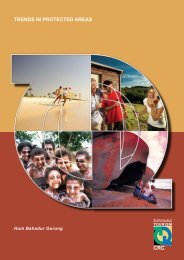icolls - Sustainable Tourism CRC
icolls - Sustainable Tourism CRC
icolls - Sustainable Tourism CRC
You also want an ePaper? Increase the reach of your titles
YUMPU automatically turns print PDFs into web optimized ePapers that Google loves.
ECOLOGY, THREATS AND MANAGEMENT OPTIONS FOR SMALL ESTUARIES AND ICOLLS<br />
Taxa Epilithon<br />
Filamentous Green<br />
Algae†<br />
Mangrove Riparian Vegetation<br />
Mullet 11 52.3 14.6 28.0 77.0 12.5 7.0 1.0 24.0 28.9 11.6 9.0 48.0 6.3 4.0 0.0 13.0<br />
Mullet 12 52.3 14.6 28.0 77.0 12.5 7.0 1.0 24.0 28.9 11.6 9.0 48.0 6.3 4.0 0.0 13.0<br />
Averages 40.0 24.7 28.5 3.3<br />
Algal<br />
Contributions<br />
64.7<br />
† In Belongil Creek, filamentous green algae was a green alga. In Tallows Creek, this component was a red alga.<br />
* Mixing model analyses were completed using Belongil source values for these 15 N-depleted consumers in Tallows Creek.<br />
Discussion<br />
Sewage Effluent and δ 15 n Signatures of Biota in Tallows Creek<br />
Previous studies have shown sewage effluent to be a major contributor to the nitrogen and carbon isotope<br />
signatures of algae (Costanzo, O'Donohue & Dennison 2000), macroinvertebrates (Risk & Erdmann 2000;<br />
deBruyn & Rasmussen 2002), individual fish species (Gaston, Kostoglidis & Suthers 2004) and taxonomic<br />
groupings (e.g. the entire fish assemblage in Schlacher, Liddell, Gaston & Schlacher-Hoenlinger 2005).<br />
However, surprisingly few studies have investigated the effect of 15 N-enriched sewage effluent on the entire<br />
aquatic food web (but see Hansson, Hobbie, Elmgren, Larsson, Fry & Johansson 1997).<br />
Our findings suggest that sewage effluent enriched the isotope signatures of all biota across all trophic levels<br />
in Tallows Creek (Figure 2). Significantly, the degree to which biota in Tallows Creek was enriched by sewage<br />
inputs was much higher than levels reported in the recent literature for rivers (deBruyn & Rasmussen 2002;<br />
deBruyn, Marcogliese & Rasmussen 2003), estuaries (Costanzo, O’Donohue & Dennison 2003; Schlacher et al.<br />
2005), bays (Hansson et al. 1997; Tucker et al. 1999; Waldron et al. 2001) and coral reefs (Heikoop, Risk,<br />
Lazier, Edinger, Jompa, Limmon, Dunn, Browne & Schwarz 2000; Gaston, Kostoglidis & Suthers 2004). A<br />
notable exception is the study by Jones, O'Donohue, Udy and Dennison (2001) in southeast Queensland, where<br />
algal δ 15 N values were as high as 19.6‰ in an estuary immediately downstream from a STP. Algal sources<br />
(epilithon and filamentous green algae) sampled in our study were less 15 N-enriched than that value, but fell well<br />
within the range reported throughout their study region (algal δ 15 N ranged from 6.4‰ to 19.6‰ in Jones et al.<br />
2001). Unfortunately, Jones et al. (2001) did not measure responses at higher trophic levels. As Schlacher et al.<br />
(2005) observed, measuring sewage impacts in aquatic ecosystems only at the primary producer level (e.g. algae<br />
and seagrass) may be misleading due to the lack of evidence relating to assimilation and trophic transfer of<br />
effluent nitrogen up through the food web.<br />
The recent study by Schlacher et al. (2005) provides a useful study for comparisons with ours as it was<br />
geographically in close proximity (less than 300km to the north) and many of the species they assessed were<br />
present in our collections from Tallows and Belongil Creeks. In our study, Sillago ciliata individuals from<br />
Tallows Creek had a mean δ 15 N value of 24.64‰ (SE ± 0.60) (Figure 2). In a comparable system (albeit a<br />
permanently open estuary) also receiving sewage effluent discharges, Schlacher et al. (2005) reported mean δ 15 N<br />
signatures for S. ciliata only as high as 15.11‰ (Table 3). With the exception of Rhabdosargus sarba, the δ 15 N<br />
signatures of specimens from Tallows Creek were consistently enriched (with a mean difference of +7.57‰)<br />
relative to the δ 15 N signatures presented in Schlacher et al. (2005) (Table 3). This substantial degree of<br />
enrichment highlights the significance of differences in hydrology and nitrogen cycling between permanently<br />
open macrotidal estuaries (like those in Schlacher et al. 2005) and intermittently open estuaries (like Tallows<br />
Creek).<br />
Food Web Structure and Function in Tallows and Belongil Creeks<br />
The impacts of sewage effluent on aquatic biota are generally reported as an increase in primary production,<br />
changes to water quality (e.g. reduced DO), a reduction in biodiversity (as only species tolerant of reduced water<br />
quality remain) and an increase in secondary productivity, as tolerant species proliferate on abundant food<br />
resources and reduced competition (Waldron et al. 2001; deBruyn, Marcogliese & Rasmussen 2003).<br />
Despite the heavily enriched nitrogen isotope signatures (this study) and high ambient nutrient concentrations<br />
(McAlister et al. 2000) in Tallows Creek (relative to those in Belongil Creek), there was surprisingly little<br />
difference in the structure of the food webs of these two intermittently open estuaries. Both were predominantly<br />
fuelled by the abundant algal resources. This finding is supported by the documented high productivity of both<br />
of these systems (McAlister et al. 2000) and reflects the well-documented importance of within-system<br />
production (usually of microalgae or microphytobenthos) in supporting fish communities in estuarine<br />
33











